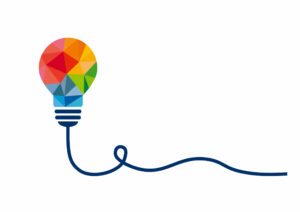Guidelines for Innovative Teaching at FAU
Teaching has an equal status to research at FAU. As an institution, FAU creates a foundation for students and teaching staff that provides the space, staff and technology for teaching and studying specialist knowledge, developing skills and encouraging personal growth.
Excellence in teaching as a driver of innovation
Teaching staff develop the content of their courses in a targeted, modern and varied manner and inspire students by sharing their own enthusiasm for their subject. They use the educational potential of the combination of analog and digital formats to cater to students’ needs and support them in developing subject-related, social, personal and digital skills. They tailor learning objectives, examination formats and teaching and learning activities to complement each other.
Within the context of innovative teaching, students and teaching staff create a space for experimentation where new approaches to and methods for teaching can be tested and continually improved. Skills are acquired through active participation on both sides: Students acquire skills and teaching staff provide their support during this ongoing process. Students’ creativity in exploratory discovery leads (later) to innovative research questions, broadens their view of teaching, and, in ideal cases, provides support for research.
Teaching at FAU addresses content that builds on the foundations of the fields of application of the subjects and also takes social questions of an interdisciplinary nature into account. The interdisciplinary investigation of this content forms a connection between teaching staff and students and leads to collaboration in the process of teaching and learning.
FAU promotes a culture of enthusiasm for development and exchanging ideas. Excellence in teaching is the joint responsibility of teaching staff, students and the institution. The enthusiasm for development in teaching is supported within the institution by means of suitable support structures and the relevant infrastructure. FAU honors skills in teaching through appropriate incentives and methods of recognition, thus emphasizing the role of teaching as a driver of innovation for the University.
1 Teaching at FAU transfers knowledge, develops skills and inspires.
Research and Teaching
As a leading research university that offers the full spectrum of academic disciplines, FAU is committed to uniting research and teaching. It ensures that pioneering research is used as a basis for teaching, also at the interfaces to new areas of research.
How can this be implemented in practice (examples)?
- The specialist knowledge taught is based on the latest research findings from the subject area, and the material covered in lectures and seminars is adapted and updated on a regular basis.
- The topicality of concepts for lectures and seminars is checked by colleagues during peer reviews.
- Teaching integrates real-life examples from research practice, including the lecturers’ own research.
- Guest lecturers from Germany and abroad report on new research projects, also online.
- Current debates in research are adapted for teaching purposes and discussed.
Foundations of each subject
Teaching at FAU teaches the foundations of each subject and demonstrates the complexity of topics clearly and within the context of the academic discourse of the specialist discipline concerned. The subject-related skills that arise from teaching subject knowledge remain an elementary objective of university-level teaching at FAU. Teaching staff and students work together to explore and achieve an understanding of the fundamental questions of a subject.
How can this be implemented in practice (examples)?
- Teaching staff integrate what is learned into the broader context of the subject (central theme is clearly discernible), for example by specifically including more complex questions in the lecture or seminar, recommended reading or by referring back to summarizing lectures and seminars during their teaching.
- Students are aware of the fact that gaining broad fundamental knowledge of their subject is essential for gaining an in-depth and specialist understanding of the subject.
- Teaching staff provide an overview of the scientific discourse in their subject, for example by providing a comparison of central positions or references to suitable basic literature.
- Teaching staff of a subject regularly exchange information about teaching the “big issues” of their own subject, for example during good practice workshops, “Tag der Lehre” (Day of Teaching) at the chair, department or faculty, or by means of University-wide digital open educational resources.
Skills oriented
At FAU, teaching aims to implement a skills-oriented approach, not only to develop knowledge, but also to develop cognitive, social, personal, methodical and practical skills to solve academic questions.
How can this be implemented in practice (examples)?
- Teaching staff and students are aware of the role the lectures and seminars play in acquiring knowledge as part of the curriculum and which contribution they make towards students achieving the required skills. Teaching staff integrate the learning objectives of the lectures and seminars into the degree program structure at the beginning of the semester.
- The learning objectives of lectures and seminars are communicated clearly to students. Teaching and learning activities are tailored to the skills objectives of the lectures and seminars. Examinations are based on the defined learning objectives – for example, the module “Introduction to academic work” could involve students drafting their own exposé and conclude with a portfolio examination including self-reflection about the learning process.
- The aim is to gain higher levels of taxonomy than merely the reproduction of knowledge. Students have the opportunity for learning in authentic and challenging problem-solving situations, for example in their own research projects.
Critical thinking
In line with its understanding of education, FAU promotes critical thinking as a universal skill in terms of a mindset that examines issues from many different perspectives. Claims to validity are assessed in terms of their assumptions using various methodological approaches and styles of thought. This encourages the ability to participate in argumentative discourse.
How can this be implemented in practice (examples)?
- Teaching staff create teaching-learning situations that engage students in “productive irritation” with regard to the object of reflection, for example by encouraging students to think for themselves by means of challenging questions or inviting them to change their perspectives through debate.
- Teaching staff encourage students to ask “why”, to justify their position in an informed manner and to critically question both underlying assumptions as well as sources.
- Students receive the tools they require to read, categorize, understand and evaluate the results of empirical studies and statistical data.
- Students have the space to reflect, for example, in times for reflection during lectures and seminars or in learning formats that openly invite questions (comments on texts, Q&A sessions, debates for and against an issue, writing peer reviews for articles, and so on). Critical questions are encouraged.
- Students are required to critically question sources of information. Teaching staff share their knowledge of subject-related discourse and reliable sources in the academic community (e.g. “How do I know which journals have a particularly good reputation? How do I know if an article has been peer reviewed?”).
- Teaching staff provide an introduction into the basic assumptions of scientific theory (ideally making explicit reference to them) and provide opportunities for investigating various theoretical and methodological approaches.
Research-based learning
Teaching staff regularly incorporate current research findings into their teaching and prepare them in a way that is accessible to students. They convey an understanding of science and academia as an ongoing and unfinished process. Wherever possible, they aim to use research-based learning as a didactic principle. Ideally, this means that students pass through the individual practical and theoretical phases of the research process and use specialist research methods during their degree programs. They are encouraged by teaching staff to question instead of accept the content they have been taught, ask questions on their own initiative and in this way explore the content in greater depth. Research-based learning occurs in the context of the conventions of each subject and includes critical analysis of problems and solutions.
How can this be implemented in practice (examples)?
- The individual phases of a research process are also conveyed in a transparent manner to students during teaching, e.g. during an introductory module or introductory events about academic working.
- Students are encouraged to ask their own questions and, from these, independently develop a research process, e.g. by writing exposés and research proposals, planning experiments and using large data sets or collections of data.
- Students actively participate in each single phase of a research process, for example during a research laboratory course.
- Practical opportunities for developing their own student research projects are firmly anchored in the curriculum, for example with lab work or field research.
- Students receive support from teaching staff with reflecting on the research process and their own scientific work, for example using feedback methods, mentoring or examination formats that document learning processes and contain elements of self-reflection (portfolio work).
- Students discuss their work with other students, for example in colloquia, student conferences or poster presentations.
Learning skills
To enable students to have the greatest degree of autonomy for their own learning process, teaching staff encourage skills for (independent) learning and strategies such as independent planning, evaluation and adjustment of their learning progress. Students learn to organize their studies as an independent process and solve any problems in a goal-oriented manner.
How can this be implemented in practice (examples)?
- Students are expected to learn the content covered by the degree program systematically, independently and in a structured manner. Teaching staff provide their support by teaching students strategies aimed at improving skills in organizing their learning process, for example by reporting about their own learning processes, providing information about learning tools (e.g. online self-assessments, digital flashcards, etc.) or by informing students about the support services provided by FAU in various areas including with respect to key qualifications.
- Students are encouraged to acquire knowledge independently, for example by means of project work or independent research.
- “Learning how to learn” is taught in specialist teaching units using specific content.
- FAU offers students the opportunity to gain these skills and acquire key qualifications. Degree program managers can ensure that content is included in the curriculum, for example with elective modules that offer the opportunity to gain credit points for teaching units in key qualifications.
- Students take on responsibility for their own learning process, for example by using independent learning strategies, networking with other students, using the relevant (digital) learning tools and by regularly reflecting upon their own learning progress.
- Teaching staff create teaching and learning situations in which students must examine their own cognitive strategies, for instance by using suitable examples to make students aware of cognitive bias such as the anchoring effect or the availability heuristic.
Enthusiasm
Teaching staff motivate students through their own enthusiasm for the topic, awaken their interest in the topic and thus encourage them to acquire knowledge independently. Teaching staff participate in the teaching/learning process by means of their ability and willingness to perceive and acknowledge students and their needs and individuality and reflect upon them.
How can this be implemented in practice (examples)?
- Teaching staff should demonstrate their own infectious enthusiasm for the subject, for example by talking about their own enthusiasm and by providing insights into their own individual experiences of learning and research, thus increasing students’ motivation for learning.
- Practical examples of the content taught highlight its relevance.
- Students are encouraged to form their own lines of thought, to be open to this process and to explore their own ideas in more depth.
- Teaching staff incorporate the topic into a wider overall context.
- Teaching staff leave room for humor.
- Teaching staff encourage students to take the initiative.
Enthusiasm is also transferred in the relationship between students and teachers. Various factors can strengthen this relationship for successful learning:
- Communication among equals strengthens the relationship and supports the learning process.
- Teaching staff should show noticeable interest in the success of students’ learning processes.
- Teaching staff take students’ issues seriously and offer their support during consultation hours or by means of feedback.
- Teaching staff take students’ everyday lives into consideration and are responsive to their needs.
- Teaching staff and students treat each other as fellow human beings.
- Teaching staff ensure they communicate in an authentic manner.
2 Teaching at FAU incorporates developments in society

Freedom
To promote innovative teaching, FAU ensures that there is sufficient variety in teaching methods and scope for individual degree program structures on the curricular level when providing a legal basis for them in degree program and examination regulations. FAU offers considerable freedom for choosing specializations and tailoring degree programs.
How can this be implemented in practice (examples)?
- Staff responsible for degree program development have a certain level of freedom in designing degree programs, for example, by including more (compulsory) elective modules and enabling individual specializations while simultaneously ensuring the skills essential to the degree program are taught.
- At the same time, they facilitate alternative examination formats (a maximum of three to four per module), orientated towards the instructional design of the modules. This ensures that students experience various different teaching and examination formats during their degree program that are oriented towards their skills, thus ensuring that purely “written exam based” degree programs are avoided to the best possible extent.
- Teaching staff use the freedom provided in the design of degree programs, for example fewer written examinations and more written assignments, including other forms of written assignments such as research reports.
- Degree program managers support the inclusion of more (compulsory) elective modules in degree program and examination regulations and individual specializations.
- Mentoring and individual support services are incorporated into the degree program structure.
- FAU is able to meet the needs of an increasingly diverse student community by increasing the flexibility of its degree programs in terms of lecture times and locations, for example by using blended learning and enabling part-time study.
Theory and practice
Close links between theory and practice allow students to acquire the skills necessary for using their theoretical knowledge to analyze and shape their future careers. Degree programs further in-depth academic knowledge while maintaining close links to practical applications.
How can this be implemented in practice (examples)?
- External experts are involved in teaching.
- Teaching staff transfer theoretical questions into practical applications, for example during field trips (also in the local area) or service learning, where students apply the theoretical knowledge they have gained during their degree in a project with a non-profit cooperation partner.
- Teaching staff encourage seminar papers or presentations that highlight the practical applicability of the content covered in lectures and seminars.
- Practical elements are included in curriculum design from the outset, for example by incorporating internships, simulations, projects, field trips and lab work.
Interdisciplinary approach
Based on solid foundations in several subjects, innovative teaching forms the connection between various disciplines and exemplifies networking and thinking on a global scale. There is scope in the curriculum to cover the conventions of both individual subjects and interdisciplinary dialog in order to tackle the major challenges of our time together.
How can this be implemented in practice (examples)?
- During the course of their degree programs, students have the opportunity to take part in interdisciplinary dialog, for example in joint lecture series, interdisciplinary or elective modules, as well as interdisciplinary specializations.
- Teaching staff discuss any issues they have in common with others, for example by teaching with colleagues from other departments or faculties, by inviting guest lecturers from other disciplines or by using peer coaching.
- The topics of lectures and seminars are selected specifically for their interdisciplinary nature or teaching staff make specific references to the relevance to other fields of topics covered.
- Students receive the opportunity to work on projects focusing on questions that interdisciplinary teams work on.
Internationalization
FAU undertakes to promote the international exchange of knowledge and the international mobility of students and teaching staff. Digital technology facilitates joint projects involving universities from all over the world and offers outstanding potential for enhancing teaching by means of international cooperation.
How can this be implemented in practice (examples)?
- New (and existing) degree programs incorporate mobility windows in order to facilitate international exchanges.
- Colleagues abroad are also involved in teaching, for example via Zoom.
- Students receive the opportunity to study abroad.
- Specialist knowledge is supplemented across national borders in double and joint degree programs.
- International students receive additional support, for example in buddy programs and language courses.
- Multi-lingual study programs promote collaboration thanks to international students and lecturers from various countries.
- Teaching staff form links to international topics and specialist discourse in areas related to their subject in other cultures.
Sustainability
Innovative teaching informs students of aspects of sustainability in their subjects and in everyday life and provides examples of action that can be taken. It integrates sustainability into the curriculum wherever this may be meaningful on the teaching unit and degree program level.
How can this be implemented in practice (examples)?
- Teaching staff and students ask themselves: To what extent does how we are teaching and what we are learning contribute to climate change and to a sustainable way of life?
- Teaching staff provide information about the Sustainable Development Goals and reflect with students about how these goals can be achieved and which contribution their subject can make in this context.
- Environmental aspects, economic and social sustainability are incorporated as specializations and communicated externally.
- Departments and faculties cooperate on aspects of sustainability.
Future Skills
Innovative teaching considers the relevance of taught content to the challenges of the 21st century. In addition to skills related to their subject, students acquire transformative skills during the course of their degree programs that enable them to address global challenges with creative solutions. During this process, they acquire interdisciplinary and professional skills that are embedded in the conventions of their own subject and that prepare them for occupations in our modern and constantly changing society. Dealing with all aspects of digitalization is one core future skill.
How can this be implemented in practice (examples)?
- Students are explicitly encouraged to carry out independent projects and are provided with any support they may require.
- Interdisciplinary projects about practical and current questions are a suitable instrument for teaching future skills.
- Conferences and presentations organized by students also promote essential transformative skills and motivate students.
- The use of digital and creative tools enriches teaching, can be beneficial to the quality of teaching and conveys transferable skills.
Diversity
Innovative teaching is responsive to the different life situations and needs of learners, thus facilitating equal opportunities without having a negative effect on the quality and aspiration level of teaching. This is where digitally-supported teaching contributes to individual learning processes, encouraging more flexible time management and providing a wider diversity of methods. At the same time, teaching thrives on the diversity of teaching staff and their own style of teaching their subject. Innovative teaching is always aware of the diversity of the requirements placed on it, thrives on a culture of diversity and incorporates diversity into its content.
How can this be implemented in practice (examples)?
- The flexibility of lecture and study times (for example, alternatives to conventional 90-minute lectures for all course participants every week, individual group tutorials, block seminars, blended learning models or part-time study models) is beneficial to the consideration of diverse life situations and learning needs.
- Teaching methods are oriented to the diversity and composition of the relevant group in the relevant semester.
- Mentoring programs, tutorials or additional services enable individual assistance to be provided to students in various skills groups.
- FAU makes teaching accessible wherever possible.
Lifelong learning
FAU encourages intrinsic motivation for constant learning and for remaining open-minded, interested and curious. FAU facilitates lifelong learning and academic training for various target groups.
How can this be implemented in practice (examples)?
- FAU offers staff training tailored to specific target groups.
- In addition, it also offers open academic courses for various life phases, such as degree programs for professional development, certificate courses, courses for school pupils, and courses for guest and mature students.
3 Teaching at FAU uses a wide variety of teaching and examination formats

Innovative and diverse teaching and examination formats
Teaching staff at FAU continue to develop and improve established formats and test new teaching and examination formats in order to achieve the goals of their teaching units in the context of the structure of the curriculum. Various teaching and examination formats are used in the degree program structure to teach and assess different skills. The focus here is on the expectations and intention of teaching staff to enrich their teaching and support students in acquiring new skills.
How can this be implemented in practice (examples)?
- Teaching staff are familiar with and use a variety of teaching formats and methods, such as face-to-face teaching, blended teaching, online teaching, lectures, seminars, tutorials, research-based learning, and problem orientation.
- Examination formats and methods (oral, written, practical, digital, individual, in groups) are based on the course content and objectives.
- Teaching staff are encouraged to participate in training for higher education teaching and are provided with up-to-date information (for example, seminars on offer, information pages with best practice examples, “Tag der Lehre” (Day of Teaching).
- Teaching staff exchange information with each other and develop courses together.
- Degree program managers structure degree programs in such a way that students can benefit from a wide variety of teaching and examination formats during their degree programs, thus enabling various skills and content to be taught in the best possible manner.
- Teaching staff are encouraged to create new high quality and thus complex formats by means of incentives such as teaching awards and the Innovation Fund.
Digital teaching and learning formats
Digital teaching and learning formats and face-to-face formats complement each other in the way in which they are interconnected. The choice of teaching and learning format is guided by the skills to be acquired by students and the added value offered by the chosen format in terms of teaching methodology. Asynchronous teaching options add value to face-to-face teaching as long as they encourage the active participation of students. These options support students with independent and flexible learning, and thus increase equal opportunities.
How can this be implemented in practice (examples)?
- The teaching format and the appropriate learning format are selected according to the competencies required and are regularly checked and adapted if necessary.
- Digital teaching and learning formats are not an end to themselves, rather they follow the principle of the added value of teaching (optimum linking of educational elements as regards the target group, course content, activities and outcomes and examination formats along the lines of constructive alignment).
- Digital education never takes place without supervision, support or interaction.
- The course content and target group are relevant for selecting the teaching and learning format.
- The various options and potential formats for digital education are considered and implemented during the design and revision of degree programs, for example by means of a checklist.
Innovative examinations and (self) assessment
Examinations pursue the teaching and learning objectives of the course within the overall structure of the curriculum and facilitate feedback about students’ individual learning processes. Keeping a record of students’ knowledge and skills involves continuous feedback beyond the scope of formal examinations. The option of using digital assessment methods is constantly taken into consideration.
How can this be implemented in practice (examples)?
- Teaching staff are familiar with a wide variety of examination formats and their advantages and disadvantages as regards teaching and organization, and use the various formats accordingly.
- FAU provides support to its teaching staff with a variety of training courses.
- Teaching staff receive advice and assistance with organizational matters when they use e-examinations and e-assessments.
- Full use is made of the potential of learning analytics.
- Self-assessments are an important component of teaching as they encourage self-reflection and make a valuable contribution to the learner’s progress.
Feedback, evaluation and error culture
Feedback to students and teaching staff as well as an error culture geared towards development give a considerable impetus to encouraging learning progress and improving the quality of teaching. Teaching staff develop new formats for their courses in conjunction with students and have the courage to “experiment” with new teaching methods, while embracing the possibility that they may prove unsuccessful. Continuous feedback to students promotes professional and personal growth. Teaching staff at FAU are aware of the importance of their role and of systematic bias in assessments and develop transparent assessment criteria.
Regular teaching evaluations enable continuous reflection and improvement of teaching. FAU provides a safe space for dialog and creates a trusting atmosphere for joint further development.
How can this be implemented in practice (examples)?
- Teaching staff try new teaching methods, exchange information and ideas with others (colleagues and students) about lecture and seminar concepts and their experiences with them, any setbacks and their visions, and allow critical feedback.
- Errors and difficulties in understanding on the part of teaching staff are regarded as diagnostic “windows”: They can help trigger a process of reflection, support dialog and identify gaps in knowledge or comprehension.
- Teaching staff use teaching methods that facilitate or even demand feedback from students, for example by means of student peer reviews, question or dialog techniques, role reversals or mutual evaluations in the team.
- Each learning process requires good interaction, well-founded feedback and clear assessment criteria. This applies equally to teaching staff and students. Reflection improves teaching and students receive effective support.
Collaboration and interaction
Teaching staff and students are aware that teaching and learning is a social process that both parties can foster through interaction. Teaching staff consciously initiate this interaction, use digital elements where they have a motivating effect and focus on group processes and communicative exchange. Students actively participate and get involved.
How can this be implemented in practice (examples)?
- Teaching staff ensure there are always enough opportunities to exchange information and ideas no matter the chosen teaching format (for example, time for questions, also between lectures and seminars, consultation hours, supporting role reversals, room for discussions) that encourage active student participation.
- Group processes are actively stimulated, for example by setting various tasks, the format of lectures and seminars, and time management.
4 Teaching at FAU is open to society and dialog

Education in dialog
At FAU, teaching is practiced as a cooperative process between the University’s organizational units (faculties, departments, chairs, centers) as well as between external cooperation partners; teaching is a team effort and each individual benefits from the joint dialog and collaborative process.
The cooperative mindset and the transfer of knowledge about good practice between its staff, students, faculties and organizational units is actively promoted at FAU and its chairs. We encourage open dialog as a means of reflecting on and improving the practical implementation of teaching and learning.
In its teaching, FAU also supports dialog and cooperation with citizens, organizations and companies to generate enthusiasm for its discoveries and research questions and to jointly address specialized topics and social issues.
How can this be implemented in practice (examples)?
- Regular opportunities for dialog are established, such as the “Tag der Lehre” (Day of Teaching), coaching, team teaching in teaching units, and peer reviews of lectures and seminars.
- Teaching staff exchange information and ideas beyond FAU by participating in national and international conferences and the acquisition of third-party funding with partners from other countries.
- All parties strengthen regular contact with partners from politics and business by means of service learning, guest lectures, teaching assignments, and joint projects.
- FAU organizes events in the context of science communication (for example, subject-related and interdisciplinary events about current issues by decentralized and central institutions and participation in the Long Night of the Sciences, etc.)
Open educational services and open educational resources (OER)
In conjunction with its partners, FAU is committed to ensuring that teaching materials can be exchanged in the academic community and are easily accessible to members of the public. With these open educational resources and open online courses, society receives a better insight into FAU’s activities, university education becomes more tangible and teaching staff can benefit from the good practice of their counterparts.
How can this be implemented in practice (examples)?
- The principle of open sharing is actively promoted and supported by FAU.
- Teaching staff can use existing materials for their lectures and seminars.
- FAU participates in networked OER platforms and also promotes exchanges via internal portals.
- Teaching staff receive advice on how to provide materials and on copyright issues.
- The process of sharing material is legally secured.
5 Teaching at FAU relies on strong support

Promoting teaching methodology skills and professional teaching
FAU promotes advisory services and support structures for good teaching and learning. It offers targeted advice to teaching staff regarding the further development of their professional teaching skills, thus promoting professional and personal training. Teaching methodology skills and professionalism in teaching and learning situations play a decisive role in selection processes.
How can this be implemented in practice (examples)?
- FAU permanently offers a range of services for university-level teaching methodology and creates the structures and incentives necessary so that lifelong learning becomes second nature.
- Teaching skills play a major role in appointment procedures.
- Teaching staff use well-equipped rooms and modern media for their lectures and seminars and make use of advisory services.
- Training programs are developed to meet the specific needs of status groups.
- Scholarship of Teaching and Learning (SoTL) is promoted as research-based teaching.
FAU publicly honors good teaching by awarding prizes for teaching.
Support and advice for successful studying
FAU is keen to actively support and guide students in their search for the most suitable degree program for them. We provide a range of information that gives a realistic impression of the opportunities and requirements of the various degree programs. Students receive continuous support from the time they apply right up to the time they complete their degree. FAU provides specific support programs for this purpose such as mentoring, tutorials or orientation courses and advisory services through the entire duration of students’ degree programs that increase students’ motivation and help them make the very most of their studies.
How can this be implemented in practice (examples)?
- Prospective students receive advice on choosing the right degree program for them, for example by means of an informative online portal about the degree programs on offer at FAU, (online) self-assessments, consultation hours or via school outreach events.
- Starting a degree program is made easier for new students by means of bridging and introductory courses.
- Advice is offered to students early on during their degree program for example by addressing them directly or via mentoring programs.
- Interdisciplinary options for degree programs such as the module program at FAU enable students to make informed decisions about which degree program or main subject they would like to study.
Infrastructure
FAU provides the infrastructure (technical equipment, rooms and staff) required for innovative teaching and promotes the maintenance and further development of digital and analog tools.
How can this be implemented in practice (examples)?
- With StudOn, FAU provides a central portal for developing innovative teaching.
- FAU applies for funding for (technical) equipment for teaching.
- Equipment for teaching in rooms in new buildings is planned with the involvement of an interdisciplinary team.




